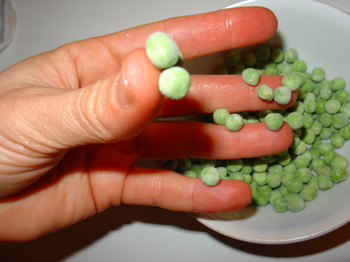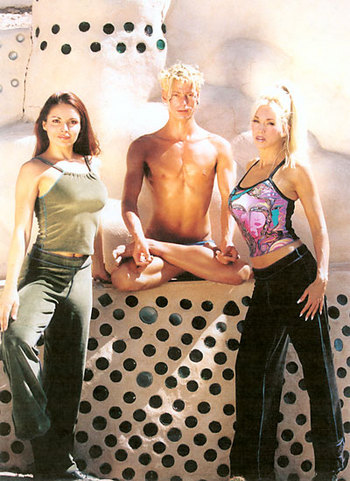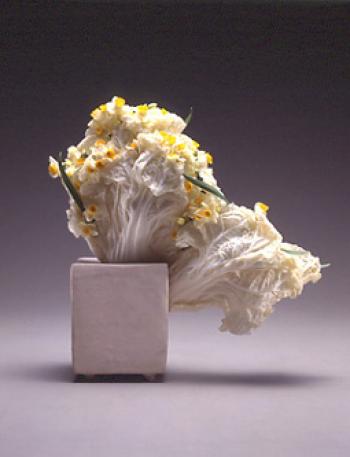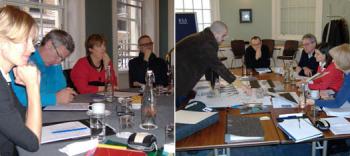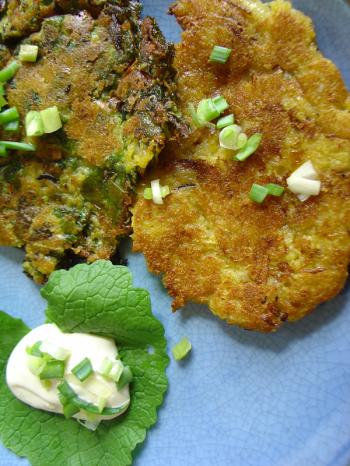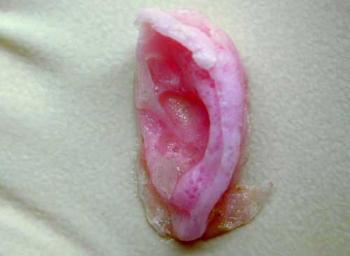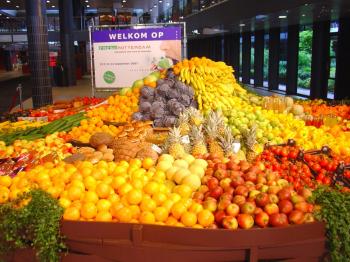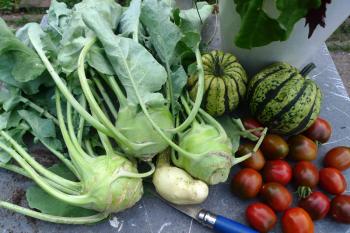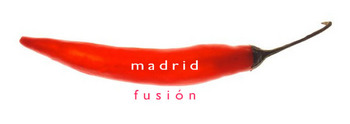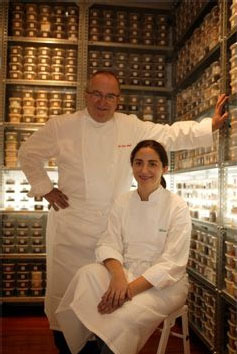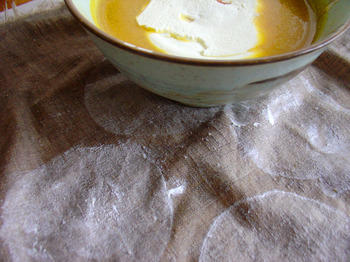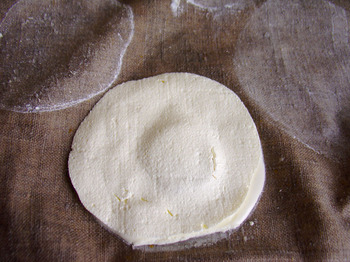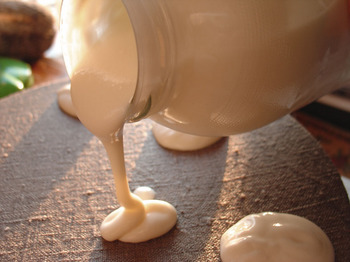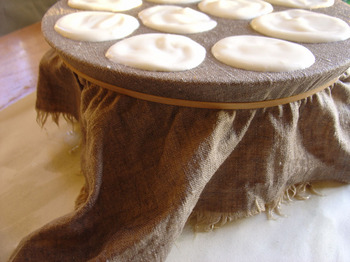Madrid Fusion, only one more day, and you can’t go
January 18, 2006
Because this gastronomical summit is all sold out. Tomorrow is the last day of the three day event, Madrid Fusion IV, International Summit of Gastronomy. The programme is filled with restaurant industry pomp and poodle, showcasing valuable marriages between top chefs and industry giants like Nestle, Knorr and Maggi. There is an all-star, all-male lineup of superchefs, save the lone Elena Arzak, but her blurb only blurbs on about her father Juan Mari’s fathomless imagination.
Enough bitching and moaning, if I had gone, I would have been absolutely interested in the designer tapas competition, because frankly, many of the conference presentations are just camouflaged sales pitches. Example topic: ‘Cheese trolleys and trays in restaurants, the last rage.’ Yeah, that’s the last rage allright, just not in my world.
My ‘last rage’ is the presence of the angelic Alice Waters, there to accept a tribute on behalf of the Summit of Gastronomy for being a ‘Founder of New American Cuisine” (Waters is above all blame) when there are such uncool conference topics about the newest recipes for serving up a fish that is widely considered to be an endangered species. Although I’d be the first one to say that a restaurant is not a home kitchen, and therefore doesn’t have the same responsibilities in terms of teaching or practicing good health and consumer behaviour, I do wish that the designers of such events would moderate their sponsors (content) and take a stand against bad practices by bad boys.
Because in the name of wishful thinking, if I had to name one food trend that I would love to see spread like wildfire this year, it would be that the world’s league of exemplary chefs exclusively associate their names and restaurants with the best artisanal and local producers, producers of sustainable products. And maybe that IS just what the good folks at the Gastronomic Summit talked about today after the ‘Cod: new recipes, a thousand flavours’ presentation. Maybe there will be brilliant debate tomorrow during the Q&A after the ‘Canned Fish in Haute Cuisine’ discussion. Heq, I won’t be there to check, but I’ll ask Alice how it went when I see her at the Berlin Film Festival Slow Food Symposium next month.
- Cod, A Biography Of The Fish That Changed The World, by Mark Kurlansky
- film trailer, We Feed the World by Erwin Wagenhofer (partially in German, and may be considered by some to be ‘challenging’. It contains the three most brilliant quotes in the film, which I’ll happily translate for you if you need it.)
- culiblog reviews We Feed the World
- animation trailer, the Meatrix2 by Free Range Studios
technorati tags: sustainability, cod, fusion, gastronomy, culiblog, International Summit of of Gastronomy, Madrid, top chef, restaurant industry, endangered species, food trends, We Feed the World
debra at 19:20 | Comments (4) | post to del.icio.us
New Year’s resolution No. 12: Make a good recipe for yoghurt ravioli
January 17, 2006
Ever since I’ve been back in the city, all I do is act like I’m not busy at all and that these short, dark days are endlessly long. It feels like I’ve got all the time in the world, which I’m guessing is a sign of mental health. Please don’t let the Languedoc wear off.
In between all the other ‘very urban, very important’ things that absolutely must get done this week, all involving lots of writing and revising and asking for huge amounts of money from those that keep our culture out of harm’s way, I somehow got the notion that now is the perfect time to develop a recipe for yoghurt ravioli. ‘Make a recipe for yoghurt ravioli’ is literally at the top of my to-do list. Imagine having my brain for only a day.
It’s the journey, not the destination, and true to form, I didn’t ask the source of my inspiration how they made their yoghurt ravioli, preferring instead to embark on a lengthy process of experimentation. Actually, all the experimenting has yielded some pretty important material information and several methods for preparation, so I’m glad I decided to not confer with those more knowledgeable and just figure things out for myself. When I think I’m done, I’ll feel more like I’m sharing and give them a buzz. Fortunately the recipe so far seems to involve a fair amount of waiting for things to drip.
Yoghurt Ravioli (recipe in development)
These are not ‘ravioli’ that you are going to cook. This is essentially a recipe for little disks of Dutch ‘hangop’, or drained yoghurt, sandwiching a filling. The fattier the yoghurt, the easier it will be to make this recipe work.
linen or tightly woven cheesecloth ~50×50cm
a big ‘ol rubber band
a large deep bowl
Fatty Turkish yoghurt (10% fat! If you can’t get this, add creme fraiche to 5% fat yoghurt - fat is good)
fleur de sel or finely ground sea salt
Soak the linen in water and wring it out. Give the cloth a good ’snap’ to shake out the big wrinkles. Place the cloth over a large bowl and secure it with a rubber band, spanning the cloth tight like a drum head and pulling down on the opposite corners a few times to achieve extra tautness.
In a wide mouthed jar, add the salt to the yoghurt and give it a good shaking. Pour the yoghurt mixture in blobs onto the linen cloth. Make rows or a symmetrical pattern to help ease the removal of the ravioli. You’ll see why you need to do this later, trust me.
Let the yoghurt drip for at least 6 hours. No need to refridgerate unless you have food phobias.
To remove the ravioli: Try to keep the linen cloth flat, avoiding as much as possible letting it bend because this could cause the ravioli to crack. Slip the rubber band off the jar and carefully lift the cloth onto a flat surface.
To fill and remove the ravioli: Place a filling on a ravioli bottom, and then, lifting the cloth, fold it over to place a ‘top’ onto each ravioli, gently letting the ‘top’ stick to the bottom. Very carefully peel back the linen, as you would remove the back liner from a sticker, and let gravity help you in this endeavour whenever possible. Do this to all of the ravioli.
Some of the many possible fillings may include:
roasted (pickled) red peppers out of a jar
saag (spiced creamed spinach)
a hunk of smoked herring or mackerel filet
tapanade
think of yer own dang filling
thawed fresh frozen peas and crumbled sheep cheese in brine
Serve up some soup that marries well with dairy, like spicy pumpkin, or borscht. It’s too wintry to fuss with contrast. Contrasts are summer’s business. Over the awaiting soup bowl, peel off the ravioli from the linen tea towel, letting it slip gently into the soup. No plopping. Nice and easy.
debra at 22:40 | Comments (2) | post to del.icio.us
Vegetation and art
January 13, 2006
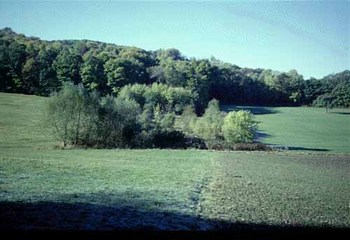
(image: herman’s meadow, copyright herman de vries)
This is an image of a meadow surrounded by farmland. Left to it’s own devices, the meadow has developed it’s own ecology, separate from the agricultural land surrounding it. The meadow is also an artwork by herman de vries, artist/botanist/publisher, who spells his name with small letters on purpose. As a land artist using the natural world as his medium, edible and medicinal plants feature frequently in his oeuvre. In an art in the public space work in the Netherlands, he planted a suburban neighbourhood with more than thirty-six species of heirloom pear and apple trees.
de vries’ work aims to create a heightened awareness with our ‘life-space’. A botanist trained in applied biology, his innovative publications frame natural products such as rose petals, thistledown, barks, mosses and roots, provoke a response far from scientific detachment. Think of an encyclopedaeic herbaria, dripping with passion and scribbles in Sanskrit, and you will have a good idea of his ‘Natural Relations, eine Skizze’. The herbarium includes more than two thousand plants and herbs, collected and logged, but the selection comes from de vries’ own memory! How’s about them apples!
The text below is de vries’ 10 theses on vegetation and art that I plucked from a book titled, ‘Transplant, Living vegetation in contemporary art’, edited by Barbara Nemitz.
vegetation and art
10 theses
* living things should be treated with repsect for their own message.
* nature is our primary reality. the experience of nature is a universal human value. vegetation is the basis of our existence.
*in art, nature becomes revolution.
* bonsai, constricted and malformed trees or plants are not art. they are perversion.
* in dealing wtih vegetation of plants in art, the artist needs in-depth knowledge about what he is working with.
* to bring plants and art together is a challenge for art.
* art in nature is totally superfluous. art can add nothing of significance to nature. the statements of nature are perfect.
* the restoration of natural relationships can be an artistic act.
* in view of what we imagine nature would do without human intervention, a park is, generally speaking, culturally impoverished nature.
* the ideals of the zen garden - asymmetry, simplicity, spontaneity, the absence of formalism - are nowhere as clearly accessible to visual experience as in naturally flourishing vegetation.
what wonderful things are “abandoned lots”, terrain vague, where mugwort, blackberries, thistles and wasteland take over.
- herman de vries
(used without permission from the publication; Transplant, Living Vegetation in Contemporary Art, edited by Barbara Nemitz / Hatje Cantz Publishers, ISBN 3-89322-971-X) www.hatjecantz.de
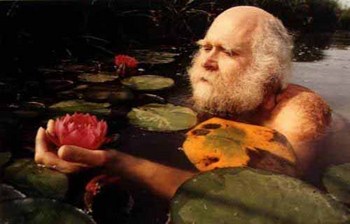
(image of herman de vries, copyright herman de vries)
- Michael Fehr on herman de vries’ meadow
- about herman de vries, Visual Research Centre, University of Dundee
- herman de vries, Sculpture Projects in Munster DE, 1997
- Dutch Foundation for Art in the Public Space, herman de vries, North of Overijssel Water Estate
- Dutch Foundation for Art in the Public Space, herman de vries, the Garden Village Collections
- October, February, June, a 1977 work by herman de vries translated into hypertext
- Individual Editions, artist editions of plant-related work
- Transplant, Living Vegetation in Contemporary Art, edited by Barbara Nemitz
debra at 21:56 | Comments (3) | post to del.icio.us

